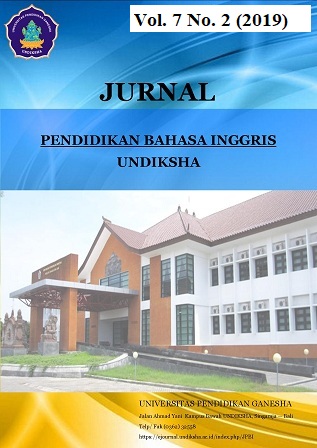THE USE OF VERBAL AND NON-VERBAL COMMUNICATION BY FRONT OFFICE STAFF TO GUEST AT DOUBLE-SIX LUXURY HOTEL SEMINYAK
DOI:
https://doi.org/10.23887/jpbi.v7i2.20414Abstract
Verbal and non-verbal communication is important for hotel staff to communicate with the guest, thus ensuring their satisfaction. This study aimed at (1) finding out the forms of verbal and non-verbal communication used by front office staff, (2) describing the function of verbal and non-verbal communication used by front office staff, and (3) analyzing the difficulties faced by front office staff in using verbal and non-verbal communication. The subject of this study were the front office staff in Double-Six Luxury Hotel Seminyak. The main instrument used in gathering the required data was the researcher and the data were obtained through observation, audio recording, and interview. Four steps were done in analyzing the data, namely: data collection, data reduction, data display, and conclusion drawing. The result of the study showed that, the verbal language mostly used by front office staff in Double-Six Luxury Hotel Seminyak in handling guest related to the guest needs and SOP provided by the hotel. There were also non-verbal language used in the form of showing interest and happiness. The reason that verbal language is used according to the study is to make the communication run well and avoid misunderstanding among staff and guests. The language barrier led the staff to use non-verbal language but they were aware that using non-verbal language could lead to some politeness issue.
Key words: communication, front office staff, guest, non-verbal, verbal
References
Ambady, N., & Weisbuch, M. (2010). Nonverbal Behavior. In S. T. Fiske, D. T. Gilbert, & G. Lindzey (Eds.), Handbook of social psychology: 464-497. Hoboken, NJ: Wiley.
Bonaccio, S., O’Reilly, J.,O’Sullivan, S.,Chiocchio, F. (2016). Nonverbal Behavior and Communication in the Workplace: A Review and an Agenda for Research. Journal of Management Vol. XX No. X, Month XXXX 1–31 DOI: 10.1177/0149206315621146
Burgoon, J. K., Buller, D. B., & Woodall, W. G. (1996). Nonverbal communication: The unspoken dialog. New York: Harper & Row.
Chan, A. (2010). The Like as interest and social gesture. Retrieved from http://johnnyholland.org/2010/09/the-like-as-interest-and-social-gesture/
Ha, E., Grafsgaard, F., Mitchell, C., Boyer, K. and Lester, C. (2012). Combining Verbal and Nonverbal Features to Overcome the ‘Information Gap’ in Task-Oriented Dialogue. Proceedings of the 13th Annual Meeting of the Special Interest Group on Discourse and Dialogue (SIGDIAL), pages 247–256, Seoul, South Korea, 5-6 July 2012. c 2012 Association for Computational Linguistics.
Hargie, O. (2011). Skilled interpersonal communication: Research, theory and practice. New York: Routledge.
Kueh, S. & Bagul, A. (2013). The Effects of Nonverbal Communication of Hotel Front office staffs upon Emotional Responses of Hotel Guests. IRACST- International Journal of Research in Management & Technology (IJRMT), Vol. 3, No.4, 126-135
Lemmer EM, Meier C & Van Wyk JN. (2012). Multicultural Education. A manual for the South African teacher (2nd ed.). Pretoria: Van Schaik Publishers.
Lin, J.-S. C. and Lin, C.-Y. (2011). What makes service employees and customers smile: Antecendents and consequences of the employees’ affective delivery in the service encounter. Journal of Service Management, 22(2), 183-201.
Lin, L. (2014). Why is Reading Your Guests' Body Language So Important?. Available in https://www.hospitalitynet.org/opinion/4066602.html
Lucas, A. (2017). The Importance of Verbal & Non-Verbal Communication. Retrieved from https://www.livestrong.com/article/156961-the-importance-of-verbal-non-verbal-communication/
Miller, P. W. (2005). Body language: an illustrated introduction for teachers. Munster: Patrick W. Miller and Associates.
Negi, J. (2009). The Role of Teachers’ non-verbal Communication in ELT Classroom. Journal of NELTA, 14(1-2). 101-110.
Nickson, D., Warhurst, C. and Dutton, E. (2005). The importance of attitude and appearance in the service encounter in retail and hospitality. Managing Service Quality, 15(2), 195-208.
Richmond, V. P. and McCroskey, J. C. (2004). Nonverbal behavior in interpersonal relations (5th edition). Boston: Pearson Education.
Rodríguez-Díaz, M. and Espino-Rodríguez, T. F. (2006). Developing relational capabilities in hotels. International Journal of Contemporary Hospitality Management, 18(1), 25-40.
Söderlund, M. and Rosengren, S. (2008). Revisiting the smiling service worker and customer satisfaction. International Journal of Service Industry Management, 19(5), 552-574.
Tatti, E. (2016). Using body language in hospitality – staff tips with Mark Bowden. Available in http://blog.typsy.com/using-body-language-in-hospitality-with-mark-bowden
Trip Advisor. (2018). Double-Six Luxury Hotel Seminyak. Review taken from https://www.tripadvisor.co.id/Hotel_Review-g469404-d6556373-Reviews-Double_Six_Luxury_Hotel_Seminyak-Seminyak_Kuta_District_Bali.html
Wardhaugh, R. (2006). Introduction to sociolinguistics (6th ed). Oxford: Black Well
Downloads
Published
Issue
Section
License
Authors who publish with the Jurnal Pendidikan Bahasa Inggris Undiksha agree to the following terms:- Authors retain copyright and grant the journal the right of first publication with the work simultaneously licensed under a Creative Commons Attribution License (CC BY-SA 4.0) that allows others to share the work with an acknowledgment of the work's authorship and initial publication in this journal
- Authors are able to enter into separate, additional contractual arrangements for the non-exclusive distribution of the journal's published version of the work (e.g., post it to an institutional repository or publish it in a book), with an acknowledgment of its initial publication in this journal.
- Authors are permitted and encouraged to post their work online (e.g., in institutional repositories or on their website) prior to and during the submission process, as it can lead to productive exchanges, as well as earlier and greater citation of published work. (See The Effect of Open Access)













